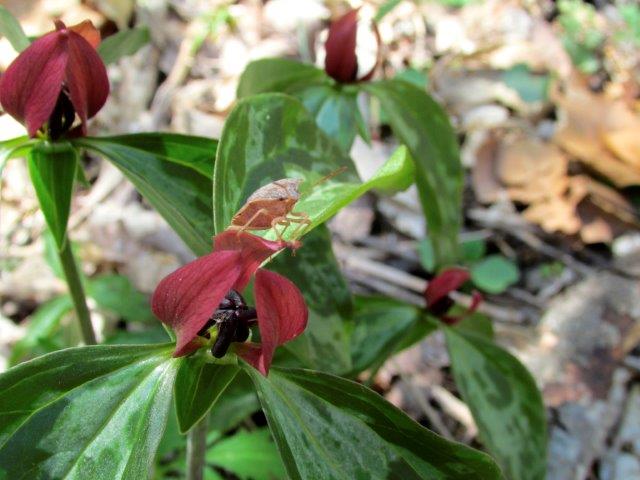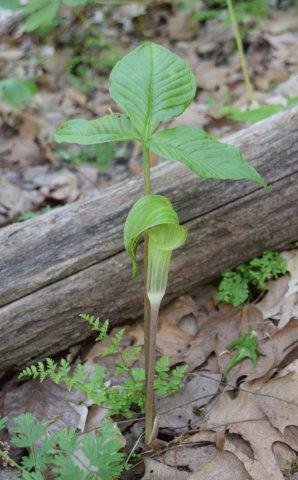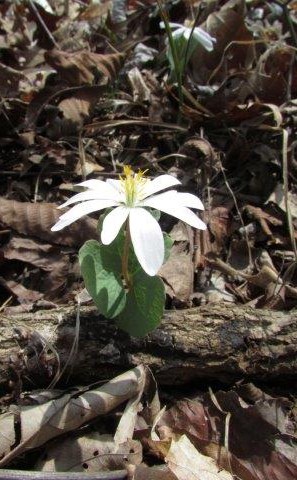A Picture Is Worth a Thousand Words: Nature Photography Seminar and Workshop

As the name implies, trilliums grow in threes, with both flowers and leaves coming up in triplicates. Photo courtesy Susan Rick, Clifftop.
Text by Susan Rick, Clifftop.
As spring approaches, the weather in Monroe County is the usual variable from one day to the next: a few days in the sixties and snow forecast in the same week. The woods, however, are slowly coming to life before our eyes. Wildflowers, insects, butterflies and birds are beginning to stir.
We are very fortunate in Monroe County to have one of the showiest and most easily accessible displays of spring wildflowers in southern Illinois. The Johnson Trail in Salt Lick Point Land & Water Reserve along the bottom of the talus slopes of the bluffs with its rich, moist soils is the home of many beautiful wildflowers.
The display of wildflowers changes as the weather warms and varies from masses of white blood root, spring beauties and dutchman’s breeches, to waves of blue and yellow when the Virginia bluebells and celandine poppies open, followed by purple phlox and dwarf larkspurs. One of the favorites mixed in among the others are the purple trilliums. Don’t forget to look up, as you may also see the redbuds, buckeye, dogwoods and other trees blooming. Taking several walks during the spring wildflower season will reward you with a multitude of discoveries along the trail.
Blood root (Sanguinaria canadensis) is a one of the earliest blooming plants and can be seen anytime from mid-March to mid-April. It is one of several early blooming members of the poppy family. The slender flower stalk emerges first to form a beautiful white showy 8-10 petaled flower with yellow centers, then the leaves unroll out of the ground. The kidney-shaped leaves of bloodroot are easy to distinguish from other plants. The name comes from the red-orange juice that comes from plant tissue especially the roots when broken. Bloodroot was used as a dye and for medicinal purposes; however the leaves and bulbs are poisonous and should be kept away from children and domestic animals.
Celandine poppy (Stylophorum diphyllum), another member of the poppy family, loves the damp woods below the bluff. The leaves occur at the base of the plant and along the stem and are divided into 5-7 segments. The flowers occur in clusters of 1-4 and are up to 2 inches across. The four bright yellow round petals occur in waves and are mixed in with the bluebells and trilliums. Yellow dye was made from its roots.
Wild ginger (Asarum canadence) has a curious flower in the crotch at ground level between 2 round heart-shaped leafstalks. It is bell shaped and reddish brown in color and lacks petals but has 3 sepals that curve back. Wild ginger also occurs in rich woods and can form dense colonies like it has along the Johnson Trail. Wild ginger was used as a spice and for medicinal purposes.
Dutchman’s breeches (Dicentra cucullaria) is another early blooming member of the poppy family. A delicate spray of white, yellow tipped flowers droop in a row from an arched stem. Each flower resembles a set of legs of tiny pants with ankles up. The leaves are delicate and highly dissected.
Bluebells (Mertensia virginica) are many people’s favorite. They grow about 2 feet tall and can be found in dense colonies along the Johnson Trail. The trumpet-shaped flowers are initially pink and open to a gorgeous blue. White and pink flowering plants are sometimes seen amongst the blue blooms.
Purple trilliums (Trillium erectum) are members of the lily family. They are easily identified since all their parts occur in groups of three. The leaves are smooth and often mottled. They also favor the rich soils below the bluffs. The liver-red petals are upright and are surrounded by 3 green sepals that are curved downward. Both roots and leaves were used in early medicine.

The "Jack" -- the flower spathe -- hides in the "pulpit," the hooded portion of the flowering stem under the three-part leaves. Photo courtesy Joann Fricke, Clifftop.
It is always exciting to see a Jack-in-the-pulpit (Arisaema triphylhum). The plant has a leaf divided into three leaflets that are attached to a smooth stalk. The flower stalk branches off from the leaf stalk near the base. The flowers are wrapped in a green sheath called a spathe which folds over at the top. In the fall, a cluster of orange-red fruit is visible. It was used as food or to treat many ailments.
To view these spectacular flowers and many others, the Salt Lick Point Stewardship Committee and Clifftop are co-hosting the annual Spring Wildflower Walk on Saturday, April 9th beginning at 9 AM. Guides will be available to help you identify the various wildflowers along the trail.

Celandine poppies shine like bits of sunlight on the forest floor in the early spring. Photo courtesy Joann Fricke, Clifftop.
Viewing all these wonderful wildflowers, we just want to dig them up and take them all home with us to enjoy over and over. They are protected, however, in the Reserve and probably wouldn’t thrive if removed from the rich, moist soils along Johnson Trail. We can capture them, so to speak, on film, and enjoy them all year long.

A stump can serve as a tripod! Hone your digital photo techniques at our Nature Photography seminar and workshop. Photo courtesy Joann Fricke, Clifftop.
Clifftop is sponsoring a Seminar & Field Workshop for Nature Photography on April 15 and 16. We are fortunate to have Chris Evans, an expert on wildflowers and photography, to lead the workshop. Instruction will be at the Monroe County Annex Building in Waterloo on Friday from 6-9:30 PM and continue in the field at Salt Lick Point Land & Water Reserve from 7:30-10:30 AM on Saturday.
Christopher W. Evans is a professional biologist and avid amateur photographer with a strong interest in helping teach others to enjoy the natural areas and native plants of Southern Illinois. Chris is an Extension Forester with the University of Illinois Natural Resource and Environmental Sciences and is the Vice President of the Illinois Native Plant Society. Chris has taught wildflower photography courses in the Shawnee Forest for the past several years.
This is a fun class that will cover basic techniques and settings used in digital wildflower photography. It will provide students the opportunity to work with the instructor in the field to practice taking pictures of wildflowers. Students must bring a digital camera (point and shoot or DSLR). Class size is limited to 15 with Clifftop members having priority. Pre-registration is required, no later than April 13, by sending an email to clifftop@htc.net or calling 458-4674. A $25 fee will be charged.
CLIFFTOP, a local non-profit organization, is focused on preserving and protecting area bluff lands.
A version of this article appeared in the 18 March 2016 edition of the Monroe County Independent. © 2016 all content rights reserved Clifftop NFP
Comments are currently closed.

